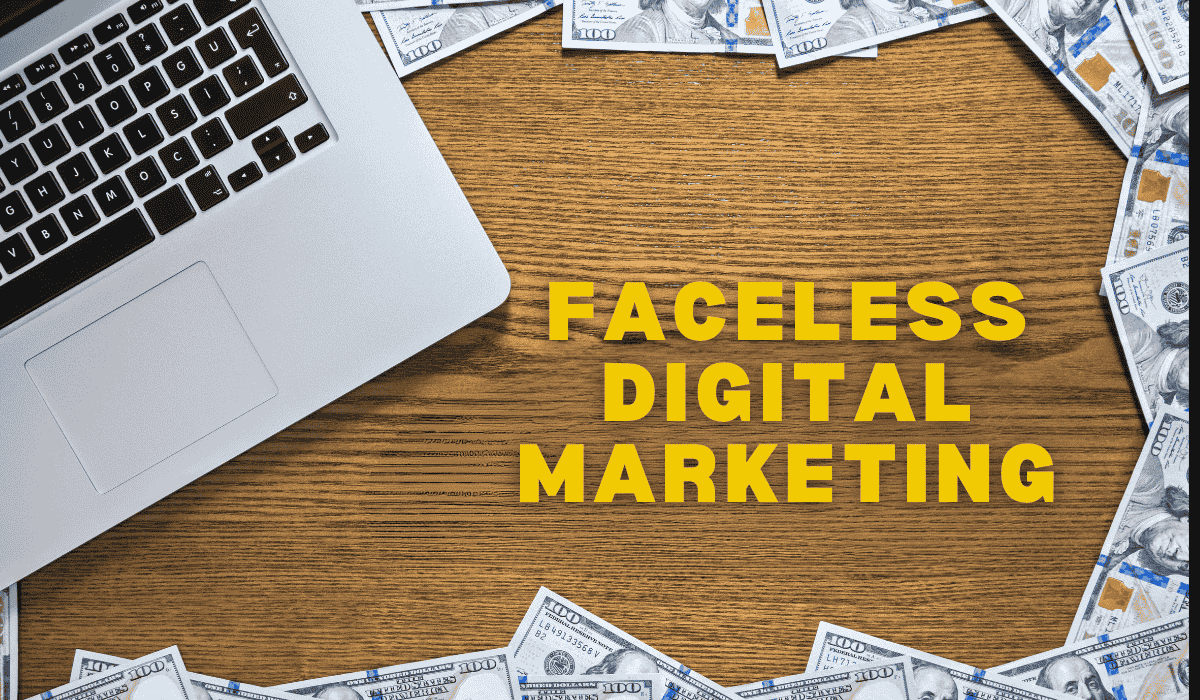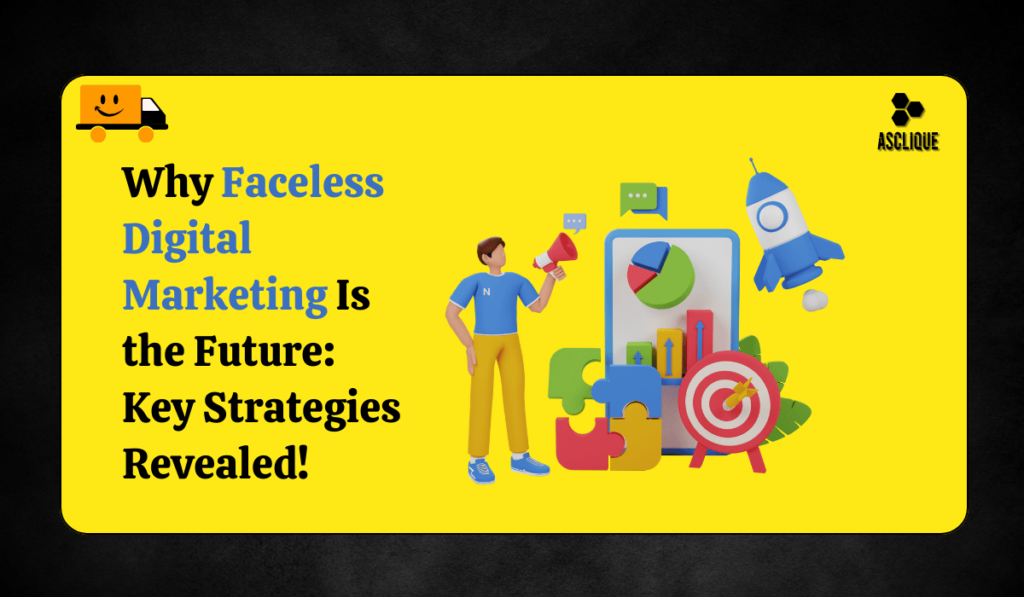Digital marketing trends bring changes to the business landscape in the way it connects with people. Amongst those, the faceless digital marketing trend, where one forgoes personal branding or an identifiable persona to concentrate solely on the brand, message, and value delivery, stands out. So, what is faceless digital marketing, and how popularly does it apply? This in-depth guide will dive into its definition, discover its advantages, and outline practical strategies for businesses ready to embrace this innovative approach.
What is Faceless Digital Marketing?
Faceless digital marketing is the process of selling a product or service without identifying the products or services with any personal identity or individual representation. Instead, it focuses on the brand’s message, content, and value proposition. This approach shifts attention from personalities to the brand itself, creating a neutral and scalable marketing style.
Some of the examples are YouTube channels, which may employ animation or voice over; social media sites that share infographics; even e-commerce builds trust by including reviews from other customers. Digital marketing does not focus on one persona; faceless digital marketing gives a wide pool of people to the company and reduces its dependency on personal branding.
Why is Faceless Digital Marketing Trending?

It has become quite trendy because, by and large, it surpasses traditional personal branding with some obvious benefits. It includes the following:
Scalability and Flexibility
- Faceless marketing lets the brand scale while remaining independent from an individual’s availability, reputation, or personal issues.
Anonymity
- Business persons who feel their personal lives should not be shared with anyone might seek ways to execute the campaign without disclosing the identity.
Focus on Audience Needs
- Since attention to individuals is absent, such strategies focus more on fulfilling the audience’s needs and providing value that increases bonding.
Cheap
- Faceless strategies commonly use AI-generated content, stock photos, and animation. It is generally cheaper than hiring influencers or building individual personas.
Through scalability, privacy, focus on audience, and cost-effectiveness, faceless digital marketing has become a robust strategy for companies to engage with their target market while optimizing their resources.
Main advantages of faceless digital marketing:
Wider Reach
- Faceless marketing eliminates the biases that personal branding may create. Without focusing on a specific individual, your brand can connect with a wider audience across diverse cultures, regions, and demographics.
Reduced Risks
- This would mean association of a public figure with the brand, hence exposing it to controversies, personal opinions, or scandals that may degrade the brand image. Faceless marketing minimizes these risks, ensuring the brand remains neutral and unaffected by individual actions.
Focus on Content Quality
- In the absence of a persona at the helm, it’s communication and content that matters for a brand. This pushes the marketer more to ensure marketing content is useful, relevant, and engaging with the target.
Automation-Friendly
- Faceless digital marketing goes well with tools of automation. With automated email campaigns and AI-generations content, it does not require a lot of personal intervention to be scheduled in advance at given times or on given dates and thus makes this process much lighter.
Cost-Efficiency
- Automation tools and skipping the influencer collaborations or celebrity endorsement help save the money faceless marketing does. Delivering high-quality marketing at a smaller fraction of costs is possible due to faceless marketing.
Easier Brand Consistency
- With faceless marketing, brands can maintain a consistent tone and message without the variability or personal quirks that come with using a public figure or spokesperson.
Strategies for Successful Faceless Digital Marketing

Leverage content-heavy platforms.
- Platforms like YouTube, TikTok, and Pinterest are excellent for faceless marketing. Use engaging formats such as animations, voiceovers, or screen recordings to convey your brand message, without needing to rely on personal appearances.
Create a strong brand voice.
- Even without a personal identity, a clear and consistent brand voice is essential. A unique tone and style across your content help build trust, recognition, and a connection with your audience. Your brand’s voice becomes its face in the digital space.
Utilize AI and Automation Tools
- AI-powered tools like content generation using ChatGPT, designing through Canva, and video editing software all increase the speed of content creation and efficiency. The tools are also quite valuable for faceless digital marketing while still holding the quality level of the same.
Focus on SEO
- Since content is the core of faceless marketing, search engine optimization (SEO) is crucial. Use targeted keywords, like “faceless digital marketing” and related terms, to boost your visibility and attract organic traffic.
Create Valuable Content
- Focus on producing content that offers real value, such as informative blogs, helpful infographics, or engaging how-to videos. High-quality, value-driven content establishes credibility and resonates with your audience, driving engagement and building long-term success.
Examples of Faceless Digital Marketing in Action
Animated YouTube Channels
- Channels like Kurzgesagt and CrashCourse excel in faceless marketing by using animations to deliver engaging educational content. These channels attract millions of viewers without relying on personal branding, relying solely on their content’s value and presentation.
E-Commerce Giants
- Platforms such as Amazon and eBay focus on user experience, customer reviews, and product descriptions rather than on the spokespeople. The sites rely on customer feedback for trust and credibility while displaying products without a face.
Social Media Marketing
- Meme pages and infographic-heavy accounts in Instagram are popular and thrive with no individual identities. The accounts are about giving content in an entertaining and easily digestible form to appeal to a large audience.
Automated Content Creation
- Many blogs and websites use AI-driven content to share relevant information without attaching a personal identity. These platforms prioritize valuable, SEO-optimized content to drive traffic and engagement.
Brand-Only Twitter Accounts
- Brands like Wendy’s or Nike engage with their audience through witty, brand-centric content on Twitter. They focus on their brand’s personality and values, avoiding any personal figures while still creating memorable interactions.
Challenges of Faceless Digital Marketing
Despite its numerous benefits, faceless digital marketing does not lack challenges in store:
Creating Trust
- Lack of a human face makes trust difficult to gain. Brands have to build credibility through very strong customer reviews and testimonials and great quality content, especially if consistency is maintained. Authority to build a credible brand is only gained through very rich content.
Differentiation
- Without a personal connection, it can be challenging to differentiate your brand in a saturated market. Faceless brands have to rely on creative and innovative content strategies to capture attention and stand out from competitors.
Connecting with Audiences
- A human face often brings with it an emotional bond with the audience, which may not be possible for faceless marketing. In this regard, a brand must create powerful storytelling and related meaningful content for its audience.
Despite these challenges, businesses can overcome them with quality content, good customer relationships, and strategic innovation, and end up succeeding in faceless digital marketing.
How to Overcome the Challenges
Invest in Brand Personality
- Your brand can be unique by building a personality with voice, visuals, and messaging. A distinct tone or design can make your brand memorable even without a personal identity.
Use Social Proof
- Trust can be established by using testimonials, reviews, and user-generated content. Positive feedback from real customers can replace the need for a personal spokesperson, demonstrating the value of your brand.
Prioritize Engagement
- Engage with your audience through commenting on posts, replies to social media posts, or live chats. Engaging interaction humanizes a brand, bringing connection without needing a human face.
Future of Faceless Digital Marketing
Thus, because of the upcoming AI, automation, and rise in privacy awareness, faceless strategies are to be on much more demand from the future in digital marketing. Brands will change other tools such as virtual assistants and AI-generated content and data-driven marketing into affecting campaigns without individuals or faces behind these campaigns.
Conclusion
Faceless digital marketing is no fad; it is a strong strategy that is very much in line with the growing demands of the new consumer: value, privacy, and innovation. Strategies include quality content, automation leverage, and engagement leading to trust-what helps brands thrive in this space. Whether small business or large enterprise, adding faceless strategies opens new avenues for growth.
FAQs
What is faceless digital marketing?
Faceless digital marketing refers to promoting a brand or product without attaching a personal identity or spokesperson, focusing instead on the brand’s message, content, and value proposition.
Why is faceless digital marketing becoming popular?
It offers scalability, flexibility, cost-effectiveness, and the ability to maintain privacy, which makes it an attractive feature for businesses interested in engaging a larger audience without personal branding.
Can faceless digital marketing build trust?
With customer reviews, testimonials, and high-quality content that has proven the reliability even of a faceless brand, yes.
How to succeed in digital marketing without a human face?
Creativity and innovation, along with a solid brand voice and visual identity, are key factors in standing out in crowded markets.
Which platforms are best suited to these types of faceless brands?
Platforms like YouTube, TikTok, Instagram, and e-commerce websites are ideal for faceless marketing, allowing brands to connect with audiences through content rather than individual personas.

